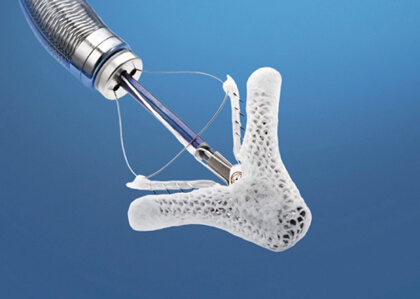Courtesy of Dr. Carlos Fava.
Tricuspid regurgitation (TR), both isolated or associated with other left valve diseases, has been associated with higher rates of heart failure hospitalization and of cardiovascular death. Recent studies in elderly high-risk patients who underwent percutaneous treatment of left valve disease have shown the presence of TR to be associated with higher rates of mortality.
 Some reports suggest that percutaneous treatment of the tricuspid valve is both feasible and safe in the short term.
Some reports suggest that percutaneous treatment of the tricuspid valve is both feasible and safe in the short term.
This study included 117 patients with symptomatic TR who underwent transcatheter edge-to-edge repair with MitraClip.
Mean patient age was 79 years old (most subjects were male) and 97% of all subjects were classified as New York Heart Association functional class III/IV. The EuroSCORE II was 6.3% and the Society of Thoracic Surgeons (STS) mortality score was 5.3%. Seventy-four patients also had severe mitral regurgitation and underwent edge-to-edge repair of both valves. Thirty-five patients who did not present differences regarding all other subjects suffered from sudden death or hospitalization due to heart failure.
Read also: Cardiovascular Events During World Cup Soccer, an Old Article Worth Remembering.
There was implantation success in 112 cases (96%). Overall, 185 clips were deployed at the anteroseptal commissures and 34 clips at the posteroseptal commissures. The TR effective regurgitant orifice area was reduced from 0.5 cm2 to 0.2 cm2 (p < 0.01).
There was procedural success (TR ≥ 1) in 81% of patients.
The follow-up was 184 days (106-363). The overall mortality was 24 patients (21%) and another 10 suffered from cardiac death. Twenty-one (18%) subjects presented heart failure requiring hospitalization.
Read also: FFR vs Angiography Guided CABG.
Procedural success was an independent predictor of survival free from death and hospitalization due to heart failure. Small TR coaptation gap size and a central/anteroseptal TR jet location independently predicted procedural success.
Conclusion
Successful reduction of tricuspid regurgitation by transcatheter edge-to-edge repair reduces mortality and heart failure hospitalization. Tricuspid regurgitation due to coaptation failure and jet location may affect the decision-making process on whether a patient is anatomically suited for this strategy.
Editorial Comment
While TR was not taken into account for many years, it has been shown to impact patient progress.
New technologies, with a difficult learning curve, prove that its percutaneous treatment is both feasible and safe, thus improving survival and heart failure hospitalizations.
A thorough exam of both the tricuspid and the mitral valve is required for proper assessment of suitable patients for this technique.
Further investigation is necessary to prove its usefulness.
Courtesy of Dr. Carlos Fava.
Original title: Predictors of Procedural and Clinical Outcomes in Patients with Symptomatic Tricuspid Regurgitation Undergoing Transcatheter Edge-to-Edge Repair.
Reference: Christian Besler et al. J Am Coll Cardiol Intv 2018;11:1119-28
Get the latest scientific articles on interventional cardiologySubscribe to our weekly newsletter
We are interested in your opinion. Please, leave your comments, thoughts, questions, etc., below. They will be most welcome.





